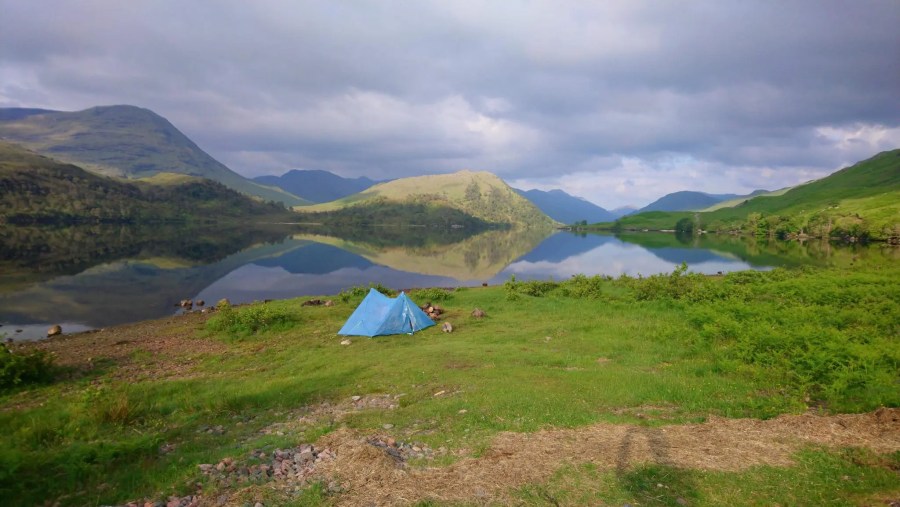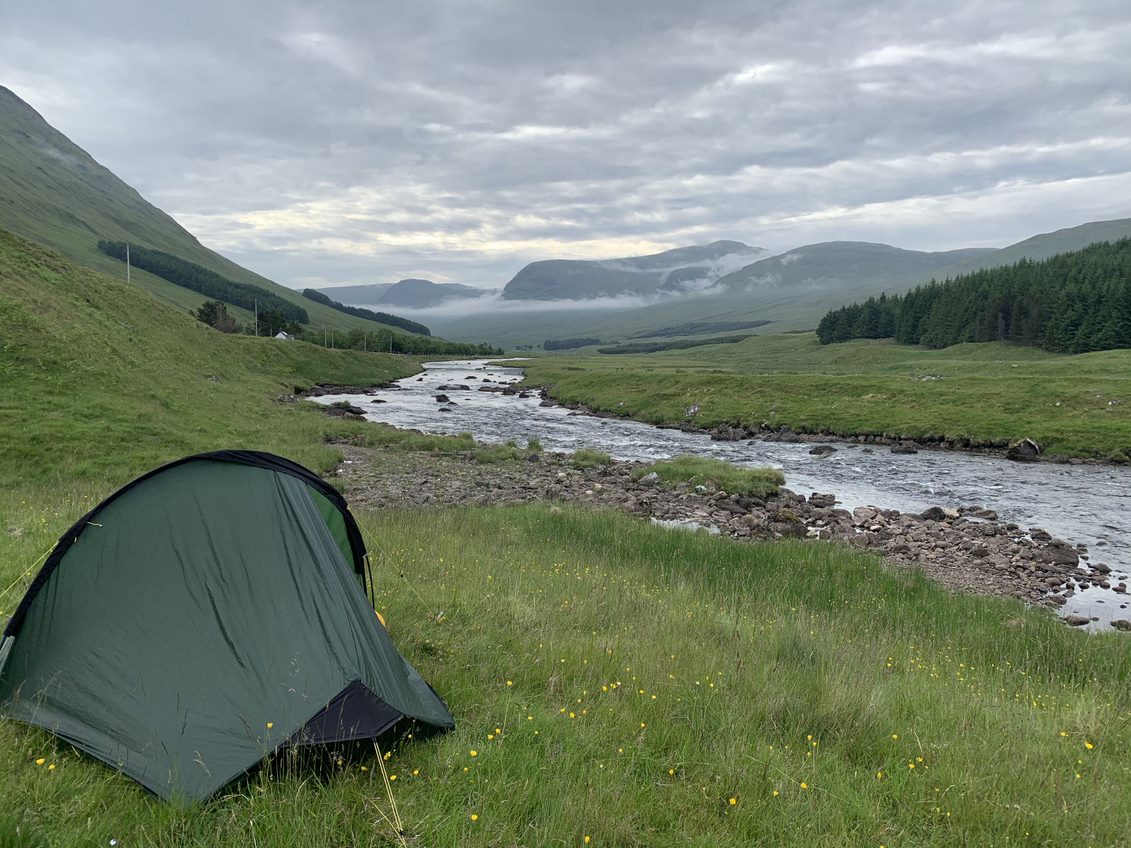Whether battling bogs or basking under blue skies, the majority of the 125 walkers who took part in the TGO Challenge this year agreed it was a particularly special event. Here, 11 ‘Challengers’ tell us the story of their crossing…
A version of this feature was first published in the print edition of The Great Outdoors (October 2021).
In June, 125 walkers hoisted their backpacks to take on a west-to-east hike across Scotland as part of the 41st TGO Challenge. Regular readers will be very familiar with the event: a self-supported coast-to-coast backpacking adventure that takes participants across the Scottish Highlands via routes of their own creation, albeit with the advice and encouragement of a central team of organisers, route-vetters and other volunteers.
And if you read last month’s edition of The Great Outdoors, you’ll know this event was a particularly special one. The Challenge was cancelled in 2020, and only went ahead this this year with reduced numbers, a shift from the usual month of May to June, and several other necessary modifications.
But the perseverance of the organisers and volunteers made it happen; and this spirit of positivity, adaptability and resilience comes through in many of the accounts from this year’s event – a great inspiration after such a difficult time. Following are eleven of those stories.
Thanks to Ultralight Outdoor Gear for giving a £50 voucher to everyone whose article was published in our print feature.
A glorious profusion
Anne Satow from Devon was struck by the natural abundance she experienced on her crossing
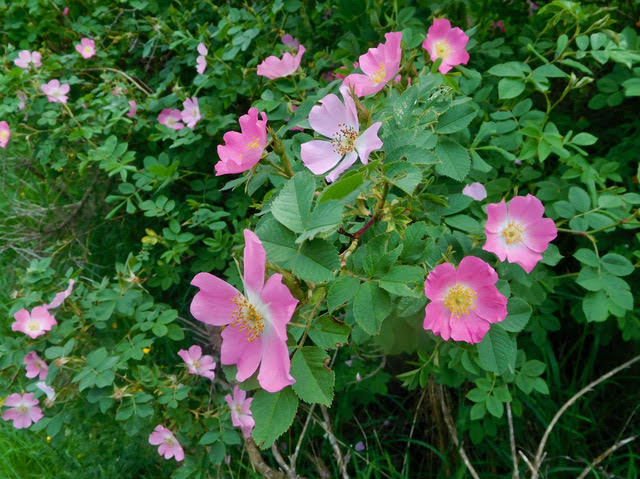
Flowers © Anne Satow
I’m falling asleep in my room at the Park Hotel in Montrose, on Scotland’s east coast, tired but exhilarated after this long-awaited Challenge. Head and legs say “Hooray, you don’t have to walk tomorrow, it’s done, never lift that heavy pack again”. My heart says: “Not walking tomorrow? Think what you’ll be missing…”
A slideshow of the last two weeks randomly plays in my head as I drift between wakefulness and sleep. Huge open skies. Stony track under my boots, stepping on stones through burns, forest paths, dried-out peat hags, squelchy off-piste bits. Glorious flowers in profusion, a June bonus – glowing banks of acid-yellow broom, white frothy Queen Anne’s lace, tall grasses, masses of fragrant pink wild roses. Flower colours mingling by the path – blue, white, pink, yellow. In the damp places, starry butterwort, sticky red sundew, bright soft mosses. Lichens transforming trees and marker posts into shaggy sculptures. Birds – a few late, forlorn cuckoos; strident oystercatchers and peewits, and floating curlew calls; a blackcap singing late into the not-quite-dark night. The eagle overhead one evening. Many small birds I can’t identify, flitting around in the woods.
Blue hills in the distance, maybe black clouds – will it rain? Blue sky and white clouds. The stillness of a loch holding its reflections. Gordon’s boat across Loch Ness. Wildlife vignettes – a beetle camouflaged on the path, a wee mole scrabbling around for a way back underground, a lizard frozen hoping I don’t see it, a deer nearby scrutinising us. Criss-crossing routes of other Challengers. Beer and cheer and fab food from the Sutherlands around the fire at Ault-na-Goire. The farmer, his daughter and her dog, rounding sheep onto summer pasture. The utter silence and everlasting daylight of a tent night.
An endless track, winding down an endless glen. Running short of water; sore feet; midges; navigational conundrums; aching ascents; a zippy nip from the hipflask. Happy evenings indoors with proper food, a welcome dram, a bed.
The slideshow fades, and I stretch in this comfortable bed. Yes, I don’t have to walk tomorrow; but my heart sighs.
This was Anne’s fourth TGO Challenge.
A picture paints a thousand words
First-timer Charles Harmer from Surrey hatched a novel plan to stave off loneliness – but found he didn’t really need it
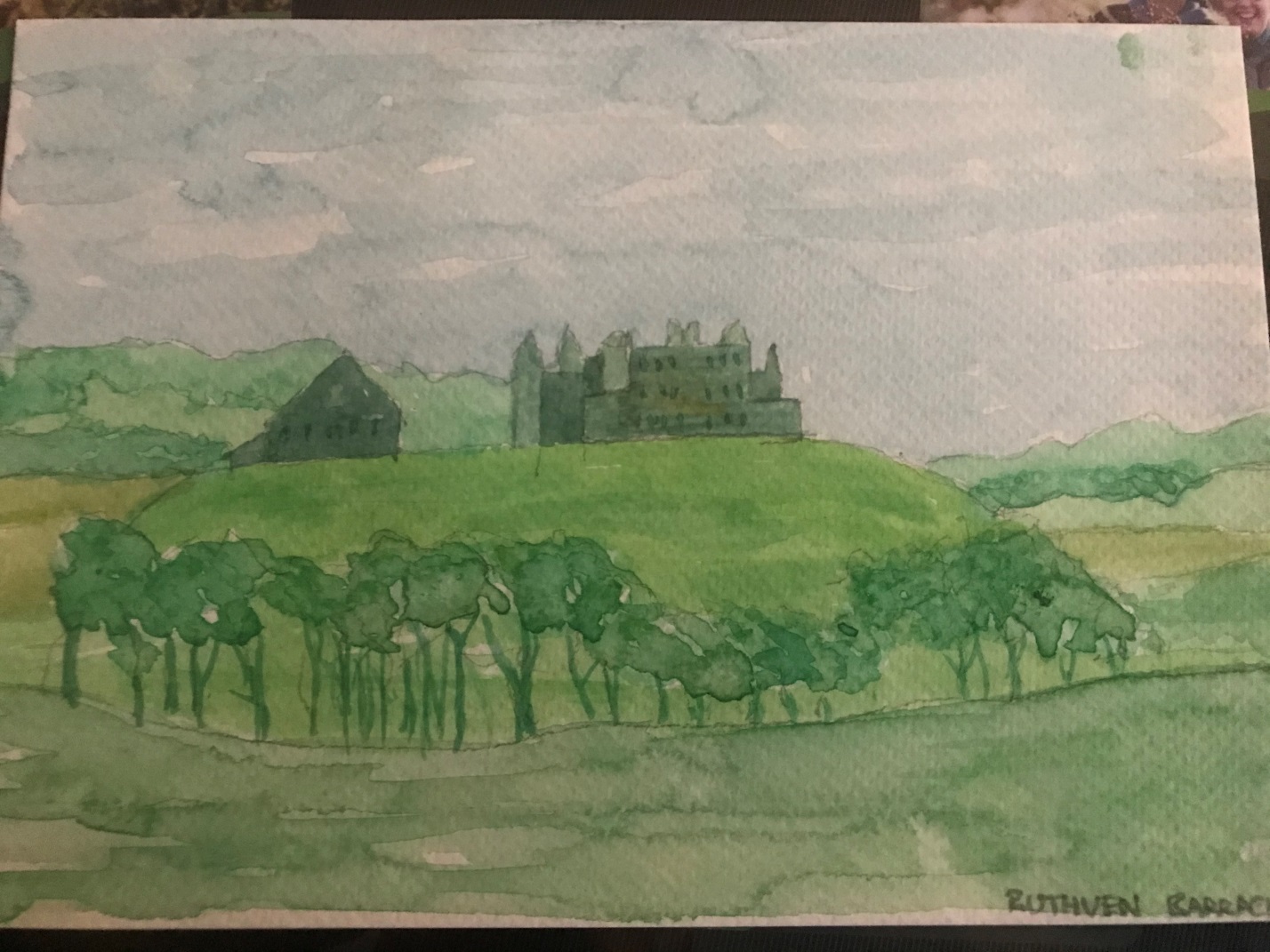
Ruthven Barracks © Charles Harmer
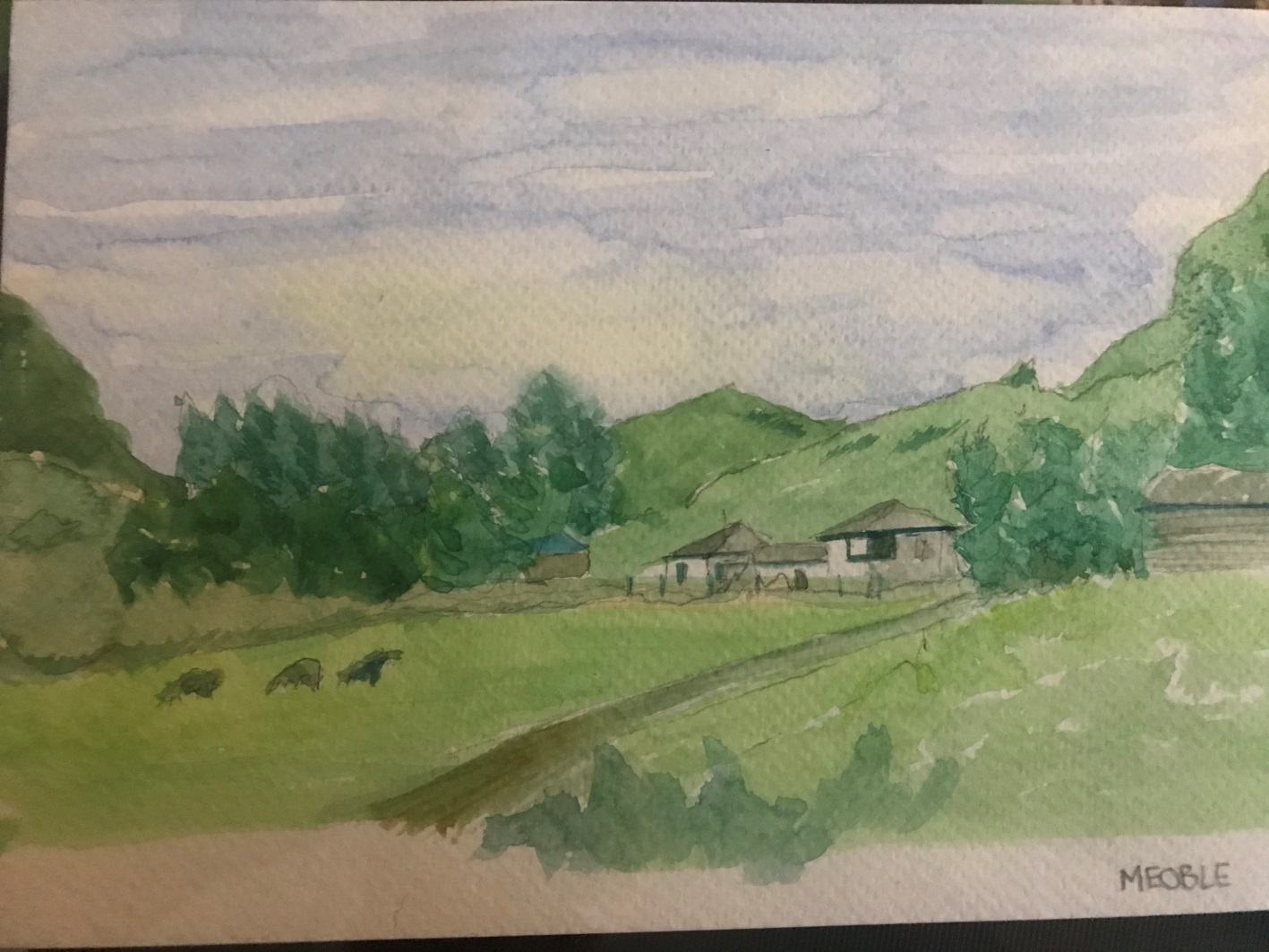
Meoble © Charles Harmer
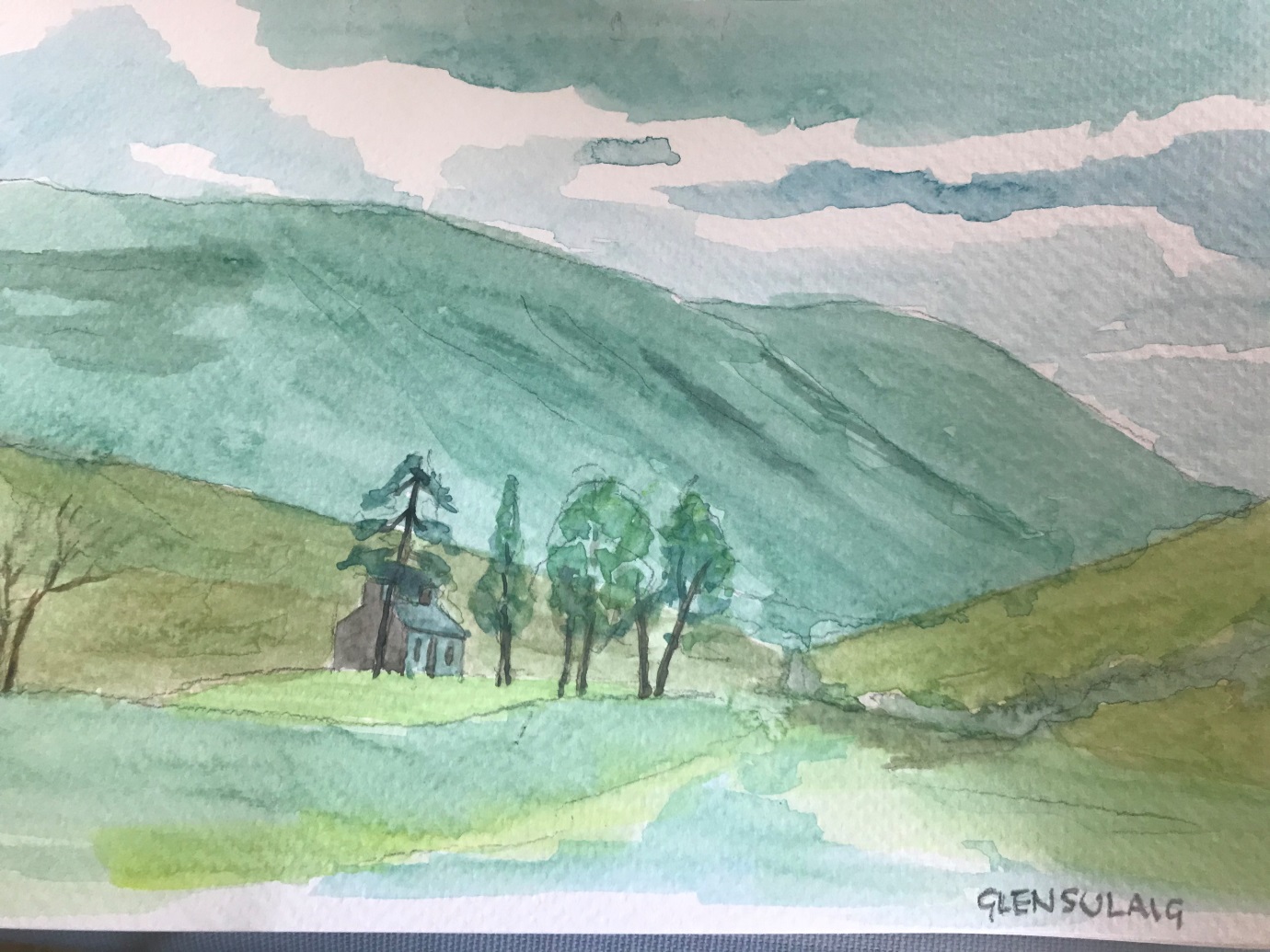
Glensulaig © Charles Harmer
It will seem strange to any seasoned Challengers reading this, but I thought I might get lonely and bored on my first crossing. With the TGO Challenge you spend a year planning for two weeks of walking. For 2021 it was two years of planning. The extra preparation time meant that I delved deeper and thought: what will I do once the day’s walking is over, and I am on my own?
My ideas for filling this spare time included reading a book and playing Solitaire. These ideas did not fill me with joy. So I hatched a plan to paint a picture each day. Taken altogether a pad of paper and some watercolours were lighter than a paperback and, I hoped, would provide more hours of amusement.
For me painting gives a chance to study what is around and really get into the view. Dabbing bits of colour onto the page requires an almost trance-like concentration. It may not be photo-accurate but it’s a representation of what I saw and felt. Every picture holds a memory to the artist of when and where it was painted: a picture interrupted by a midge attack; a picture rushed and the paint blotched during a downpour; an unusual colour because you couldn’t find the right one.
In the end I painted most days. I enjoyed the relaxation either during or after the day’s travel. It was a bit of meditation, stillness after the rhythmic walking. It’s also a lasting memory of the day.
Something must have worked as I was never lonely or bored on the Challenge. It could have been because almost every night there was someone interesting to talk to. There is camaraderie in the select band of people that choose to walk and camp out in the Highlands. To banish loneliness and boredom you could try painting; but to be honest a more effective cure is the generosity and good company of other hillwalkers.
This was Charles’ first crossing.
Passing through
Dean Jagger from Somerset found his crossing caused him to reflect on fragility and interconnectedness
As I descended Mam Meadail and the ruin of Carnoch appeared, I had the feeling I was entering a world before words. It brought me to a complete standstill.
This year’s TGO Challenge was, of course, held later in the year than usual, and the middle-of-June flowering stopped me several times. At this spot, Loch Nevis washes the shore with salt whilst the River Carnoch and its tributaries bring fresh water. I stooped to look closer. Green fingertips of sundews offered me a cluster of what looked like Christmas baubles. The mauve hoods of water avens shyly turned towards the earth, contrasted with the confident display of orchid and thrift. There was a fragility about it though, this plant community. The Carnoch ruins were a testament to the paradox and ambiguity of inhabiting a place we are only ever passing through.
From my start at Glenelg, despite 40 miles and three days of walking, I hadn’t yet left the west coast. Necessity, potential and unavoidable contingency encouraged me on. As it is with life itself, this was a journey of inter-relationship and coexistence. Lowland species mixed with true montane species. There was alpine lady’s mantle, cloudberry, one-flowered wintergreen, wood vetch…
I must stop there, aware of having gathered a large bouquet without plucking a single flower. Connecting with the natural world on a journey like this is like a hand that touches; you are also simultaneously touched. How good it felt.
This was Dean’s fifth TGO Challenge.
Two Grahams fail to climb a Graham
Graham Horsley completed this year’s Challenge after a retirement move and some health challenges
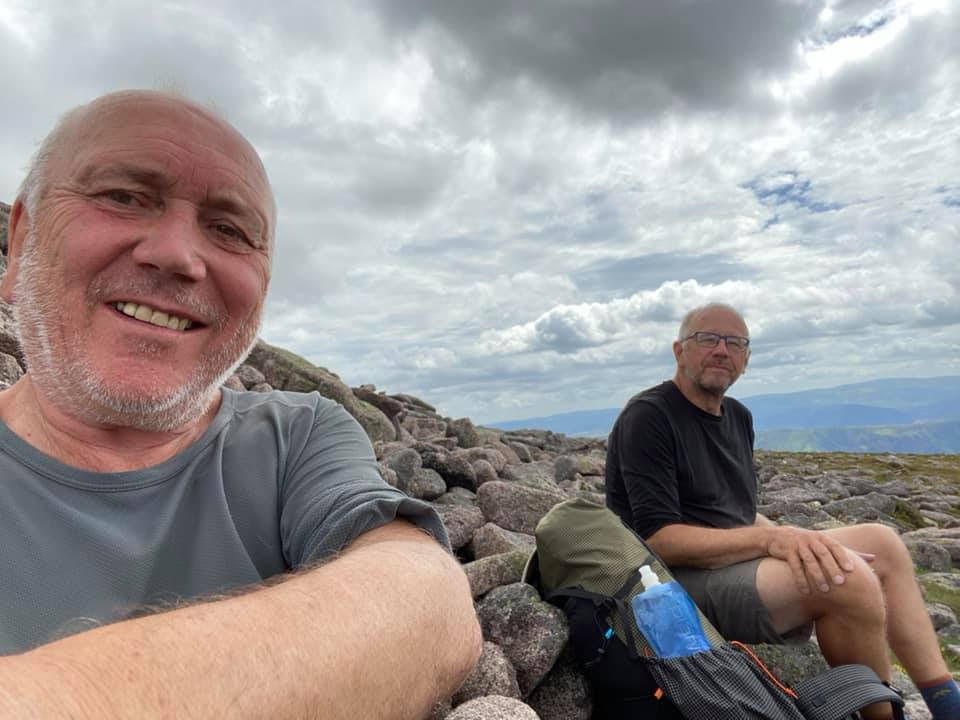
Mount Keen © Graeme Currie
I approached this year’s TGOC with more trepidation than my previous long walks. Not because of lockdown – a retirement move from Surrey to Shropshire meant I’d had lots of hill time. A stroke, vertigo, a broken wrist and a hernia in the six months prior to TGOC were my welcome to retirement. However, both my consultant and GP encouraged me to participate.
We blended in well with the other walkers – Graeme in a fetching pair of pink linen shorts and myself with luminous green walking shoes. Our route was a demanding one from Strathcarron to Kinnaber Links. After statutory photos with other Strathcarron starters we were off – straight uphill. The first day was a leisurely yomp to Loch Calavie, followed by a tough low-level walk round Loch Mullardoch, made easier by the fact that the water level was low enough to walk along the lake bottom.
Next day we took the newly created Affric-Kintail Way to Drumnadrochit, where we met the most Challengers so far in the wonderfully enjoyable ferry crossing and delightful camp at Ault-na-Goire. It’s amazing how welcoming people are to TGOers.
The Monahdliath mountains were definitely the low point of the crossing. It took us more than twelve hours walking to finish the day 4km short of our planned camp. The next day we started at 6.00am to get back on schedule.
We skirted the Cairngorms using some good navigation to cut the corner to Faindouran Lodge in horrible weather – the sort of night when a bothy rather than a tent was sheer luxury – then a leisurely valley walk to Braemar. Our sole Munro was Mount Keen, then downhill all the way to the coast. By now we were ahead of most Challengers and arrived in Montrose in time for the footy: a strange anticlimactic ending with little celebration or crowds, but the same sense of ‘we did it’.
This was Graham’s third Challenge.
The agony and the ecstasy
Hattie Taylor from Hertfordshire, walking with Patrick Davis, discovered the highs were worth the lows
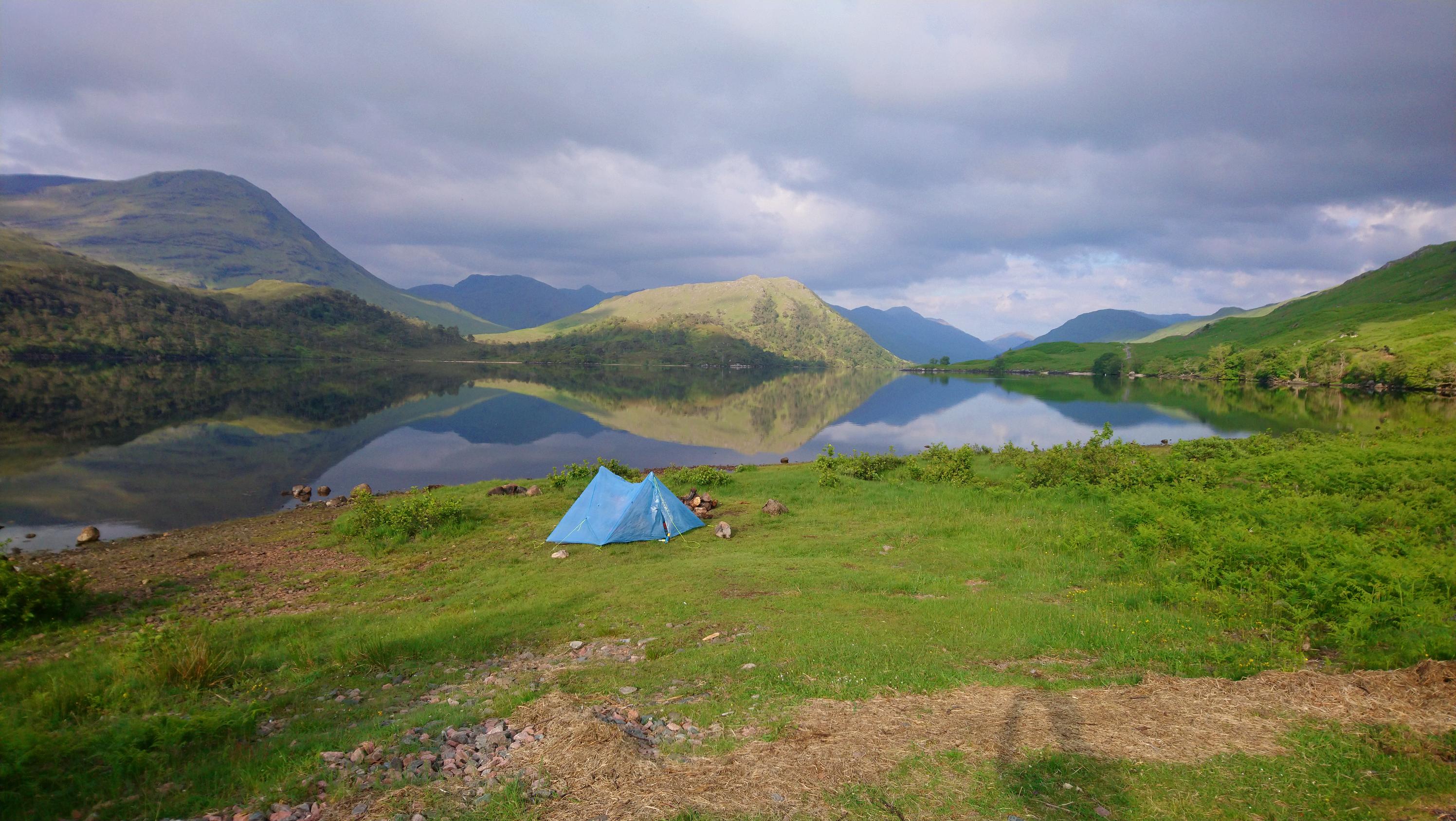
Camp at Loch Arkaig © Hattie Taylor
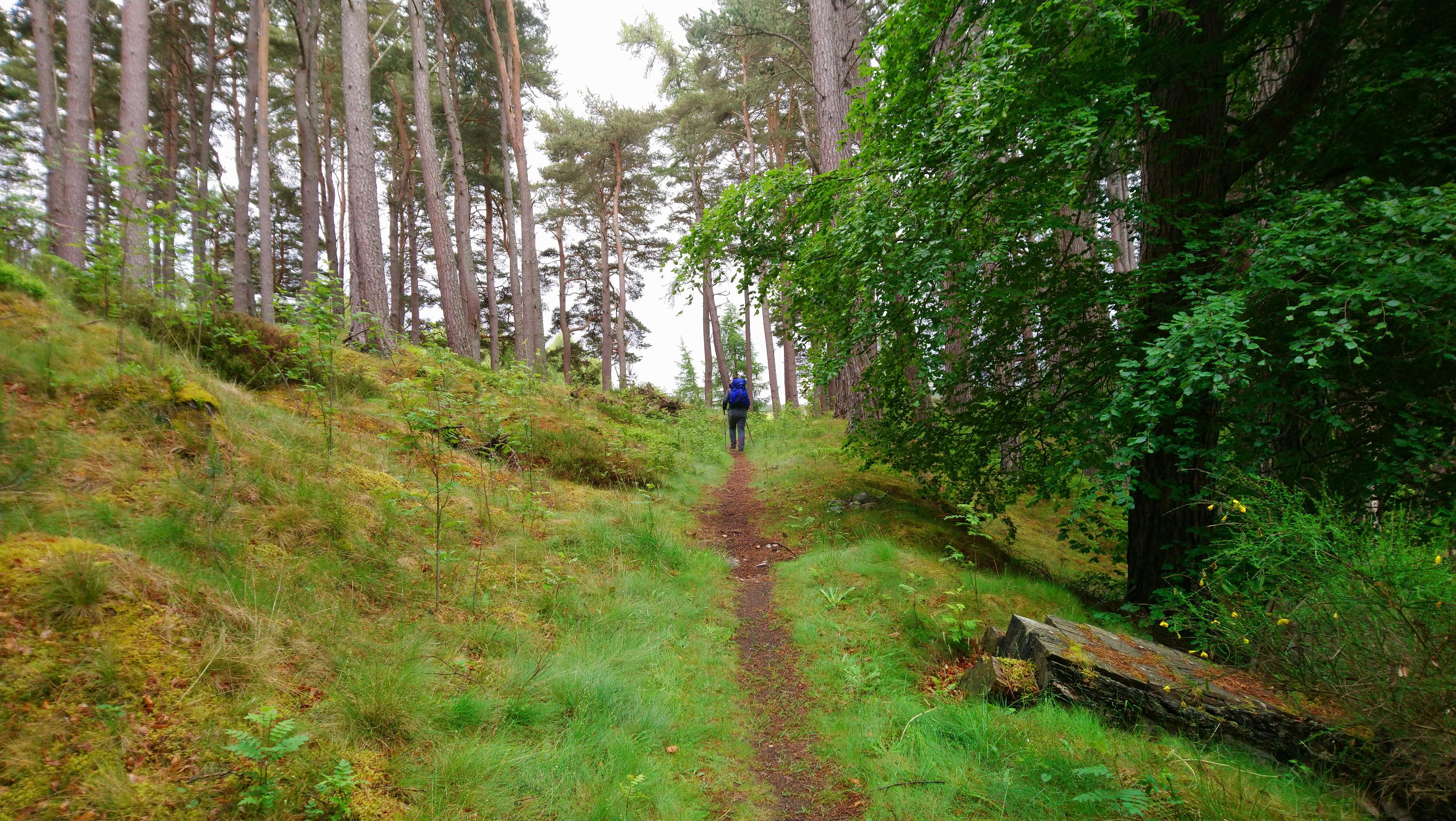
Path through the trees © Hattie Taylor
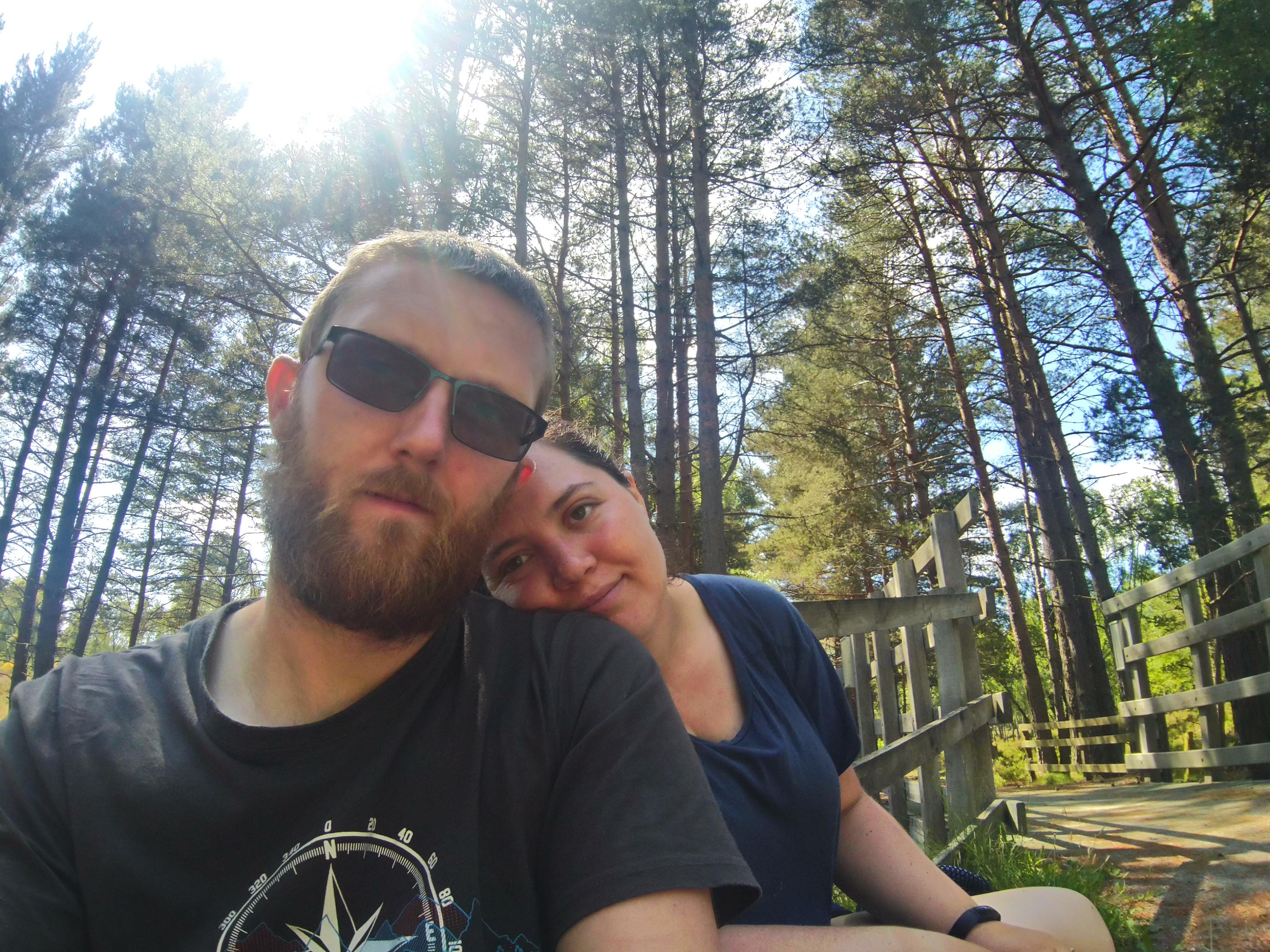
On the Deeside Way © Hattie Taylor
“A bus?” The man asked shaking his head in confusion. “How did you get here?”
Too quickly I replied, “Walked. We walked from Mallaig!” Pat grinned next to me, tender feet resting on the warm sand. “Where’s that?” the man asked. “The west coast.”
We had just walked the 180 miles from the west coast to the east coast of Scotland, ending at Dunnottar Castle on a day with perfect clear skies. Blisters, sunburn, aches and even midge bites were temporarily forgotten. We were simultaneously overjoyed to have achieved the Challenge we had spent months preparing for and desperately sad that it was all over.
Our rucksacks, dirty and battered, lay in the sand next to us. For two weeks we had hauled them through rain, blistering heat and clouds of midges. In them we’d stored everything we needed to survive, including the little blue tent that we now thought of as home.
Setting off on the first day from Mallaig, the sky was clear. Our packs felt light. We had two full weeks ahead of us. It was perfect. Then the midges came. Trekking through a bog, in the heat, with our heavy packs it felt like we may not have made the right holiday choice. Then we turned a bend in the path and Loch Nevis opened up before us, bathed in the light of the setting sun, framed by the distant mountains, a herd of red deer by the loch’s edge. It was an image so close to my idealised image of Scotland I could scarcely believe it was real.
For the duration of our adventure we found this pattern repeating: one minute everything hurt and we were sure we would never finish, the next we were walking through a fairy tale.
And as soon as we set foot on that homebound bus we were already planning our next TGO Challenge…
This was Hattie and Pat’s first TGO Challenge.
Whither the weather
Ian Calder from Surrey found that Scottish weather can always be relied on to be unreliable
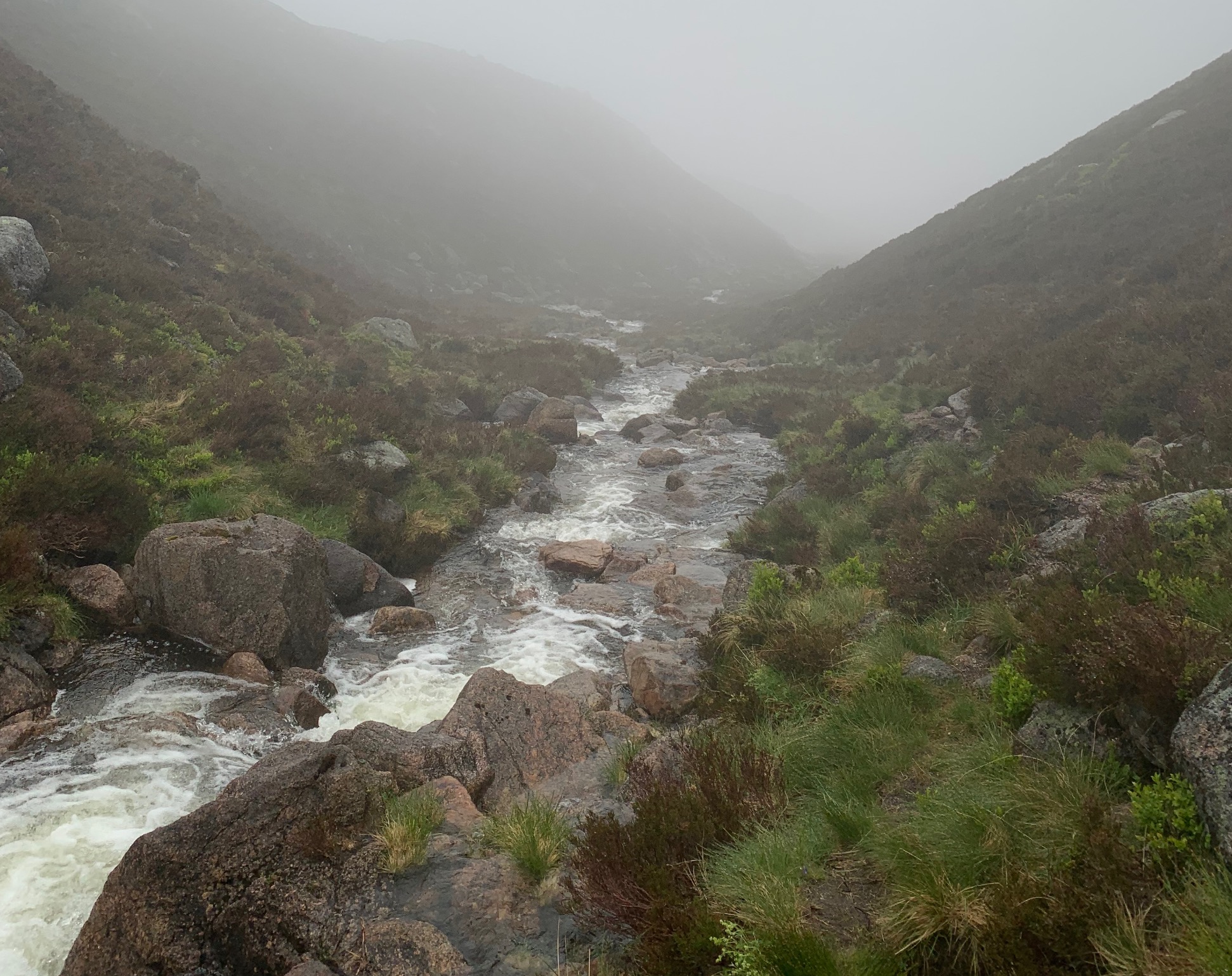
Summer in Strath Nethy © Ian Calder
It was day eight of the 2021 TGO Challenge. The sun was shining as I left Coylumbridge, but by the time I got to the Garbh Allt river crossing it was looking decidedly gloomy on the high ground.
From the river I could see no more than 50 metres of my intended route, which would take me up into the murk to the east of Coire Odhar. I checked the OS map, and there looked to be a faint track by the river in Strath Nethy keeping me out of the clouds and away from the worst of the weather; or so I thought. I sent a text to Challenge Control to let them know of my route change, and headed out.
Within the hour the murk and the rain had worsened. I laughed out loud when reading the text response from TGO Control informing me “not to take the path in Strath Nethy” as it was “non-existent in places and very boggy”.
The boggy ground had descended into a full-on swamp that Shrek would have been proud of, and what remained of the track was now running with a torrent of water. I resembled Tony Hart’s Morph; covered in mud and getting worryingly cold.
By the time I reached the small windowless refuge at the Fords of Avon I felt like I’d been open water swimming for three hours, fully clothed. Inside were a fellow Challenger, Ian, and a wildlife photographer. I’d put my night-time woollens on and settled down for what was likely to be an uncomfortable sleep when the door opened and Jenny and Gordon, intrepid TGO travellers, shivered in. Five wasn’t going to work in this tiny refuge so I put my wet waterproofs on over my night-time gear, committing the umpteenth schoolboy error of the (very long) day, and ventured out into the biblical weather to pitch my tent.
Mark Twain famously said “The coldest winter I ever spent was summer in San Franscisco”. He clearly hadn’t been to the Cairngorms in June.
This was Ian’s second TGO Challenge.
A shared purpose
First-timer Innes McKendrick from Inverness-shire was struck by the sense of support and community at the heart of the event
For me, plotting a route is a way of imagining the future. Looking at a map, satellite pictures, and mentally placing yourself on the terrain as you make each decision. How great will it feel to gaze out from this summit in broad sunshine? But what about in lashing rain? Drawing a line across the map takes seconds, but how will your feet ache after that six-mile roadwalk? Would you prefer wet shoes and a bog? It’s an exercise not only in knowing the landscape but in knowing yourself, and creating something for a future you to enjoy.
When I first entered the TGO Challenge, I felt intimidated. I thought I might be capable of putting together a route across Scotland, and hopefully of actually walking it. But the idea that expert vetters would check my homework to ensure my plans were up to scratch seemed terrifying. If I’d designed an impossible route, heading directly off a cliff and somehow ending up in Wales, I’d far rather find out quietly and keep it to myself.
Once I finally summoned the courage to submit my work though (right before the deadline), my worries were quickly silenced. The response wasn’t simply a pass or fail on the viability of the route, but an expertly detailed commentary of notes and advice. I immediately felt the comfort of another person’s investment in my journey.
That atmosphere of support and community progressed naturally onto the walk itself, so by the time I set off I felt more excited than anxious. I guess for experienced Challengers, this year might have felt lonely. As a first-timer, though, the shared sense of purpose and mutual desire for everyone around to succeed was what really struck me. Between the helpful phone calls to HQ and the friendly greetings when I crossed paths with other Challengers, it was impossible to feel isolated.
During lockdown I suspect we’ve all done a bit of living in the future, planning and imagining. I’m beyond grateful that I got the chance to translate my route into reality. And, of course, I’m already plotting the next one.
This was Innes’ first TGO Challenge.
There’s always Plan B
Paul D’Ambrogio from Wirral scrambled to rework his plans along with the TGO team after a certain virus almost derailed his crossing
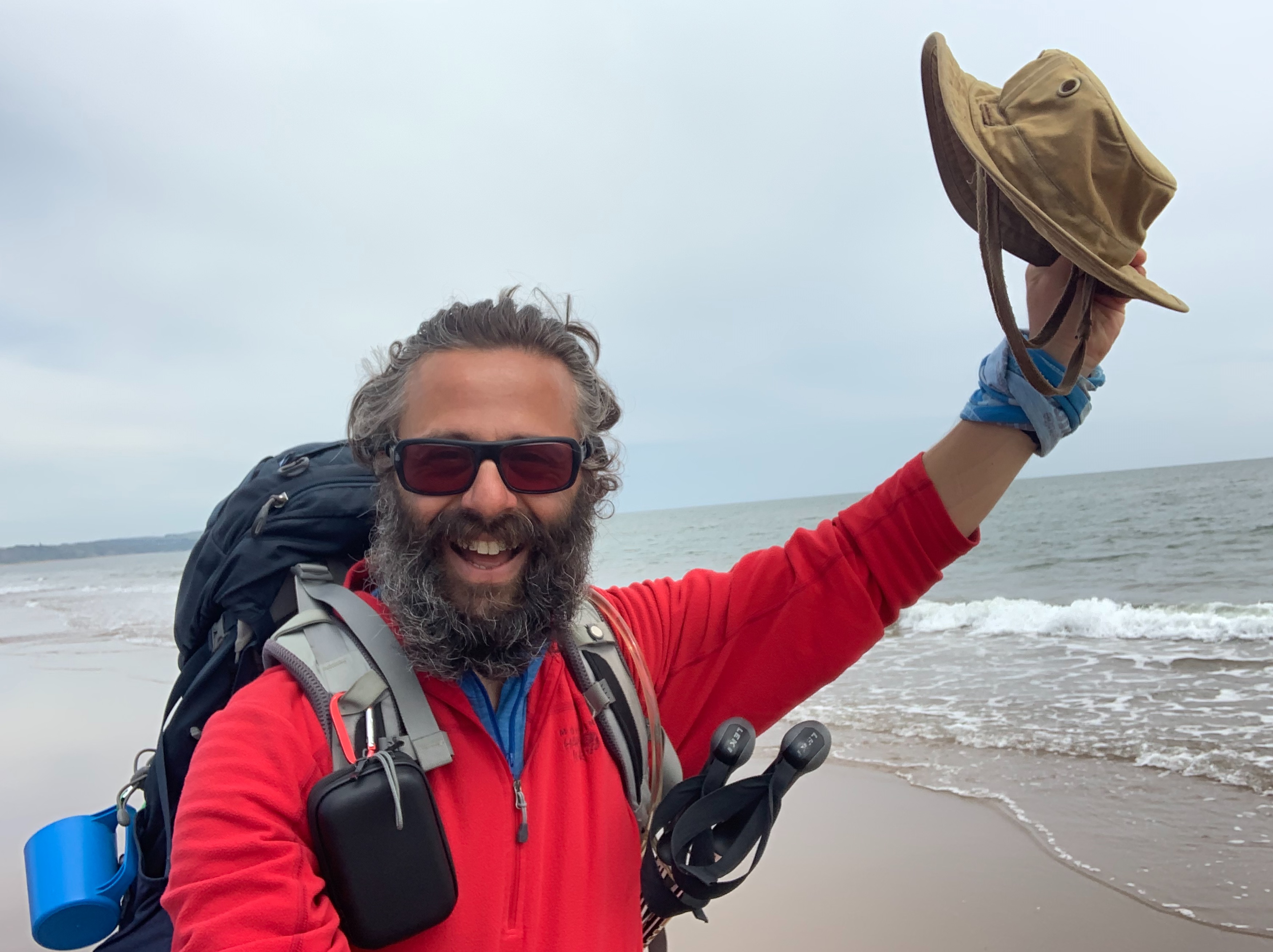
Finished! On Montrose beach © Paul D’Ambrogio
I finished preparing for the 2021 TGO Challenge by January 2021. However, what I didn’t anticipate was my daughter testing positive for Covid shortly before I was due to set off on June 17.
My isolation period would end on June 24. The Challenge was due to end on 2 July. This would give me eight days to complete the route.
Would it be possible? I had previously done the Challenge within 11 or 12 days, but never eight. My daily distance would need to be a minimum of 30 kilometres (18.5 miles). It would require early mornings and late nights. There could be no rest days or easy half days. But this was exactly the sort of Challenge I needed.
I took another look at my route sheet and decided to start afresh. With the help of Challenge Control – Ali, Mick and Gayle – I came up with a fresh route within a few days.
I dealt with each day one at a time. I couldn’t look any further than that day’s problems. On one day I was forced to walk 48 kilometres because I couldn’t find a suitable camping spot. However, it did mean that I arrived in Blair Atholl early for a well- deserved beer and shower (in that order).
For me, this was what it meant to undertake the Challenge. It was supposed to be challenging – not only physically but also mentally.
I cannot express how euphoric I was in entering Montrose. However, even my last day was not without incident, as I was reprimanded by a ScotRail employee for walking on what I thought was a disused railway line.
Would I do the TGO Challenge again? Try and stop me?
This was Paul’s seventh TGO Challenge.
A taste of normality
Paul Dudchenko and his wife embrace a return to normality
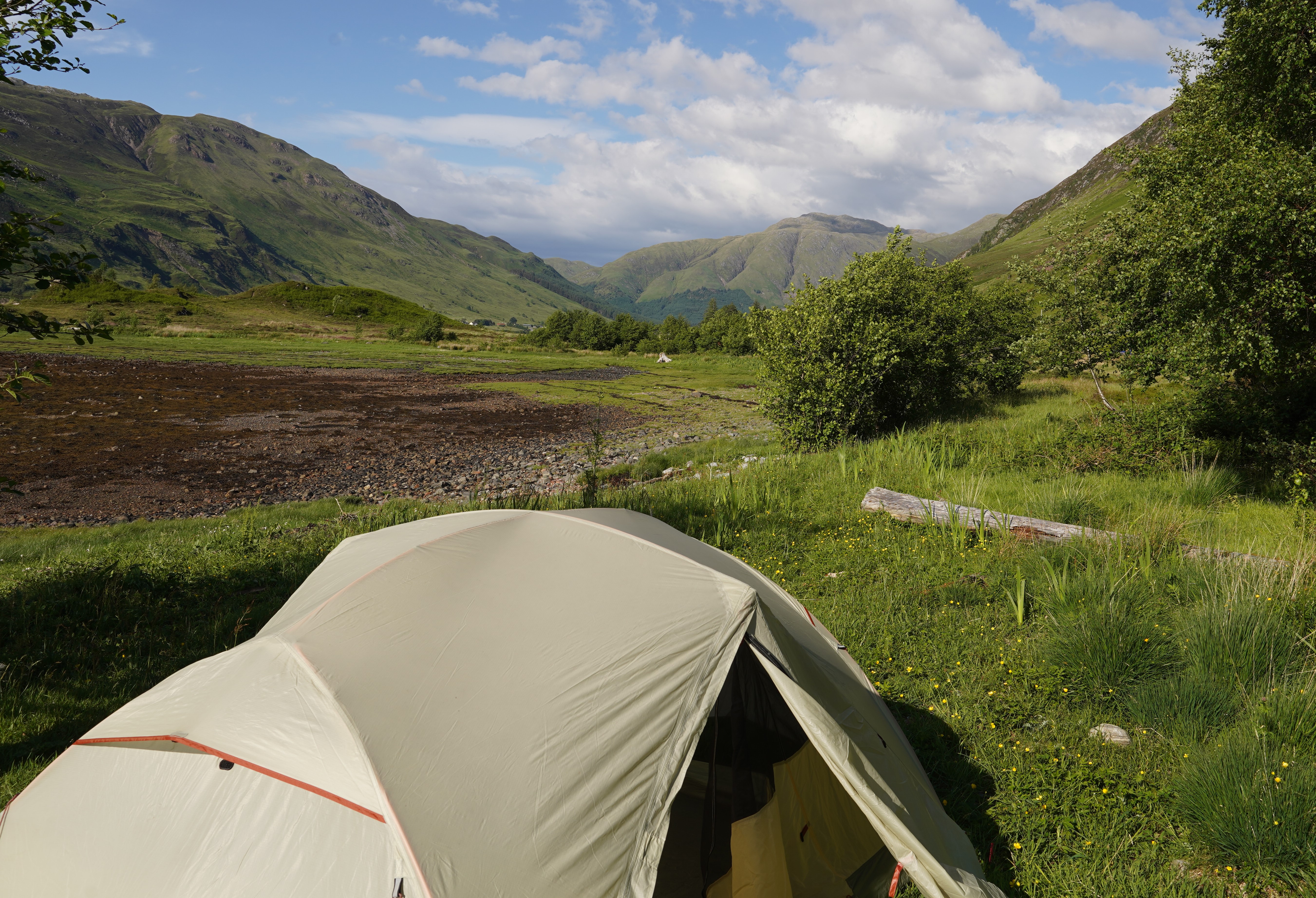
In camp © Paul Dudchenko
My wife and I arrived in Shiel Bridge, our start point, on the first day of the Challenge and found a wonderful place to pitch our tent near the shore. We walked to the nearby Kintail Lodge Hotel for dinner and pints of Skye ale with the England v. Scotland European football match on in the background. It was our first significant trip since lockdown and one of our first dinners out. Yet it felt normal. It was hard to imagine that the trip had been preceded by a lengthy lockdown and a year and a half of working from home.
The next day we followed the Affric-Kintail Way to Glen Affric. My wife opted to add a Munro while I set up camp in the glen, but I was soon forced to retreat into the tent. At just about 6 p.m. the breeze dropped and the midges came out in force. There is a reason that the Challenge is usually in May: by mid-June the midges are most definitely out.
We next did a 19-mile day to the campground in Cannich. Again, we enjoyed an evening meal out, this time at The Slaters Arms. My wife was feeling the miles the next day in her hips, but we reached Drumnadrochit in the late afternoon without incident and checked into the friendly Loch Ness Hostel.
The following morning my wife departed (her plan was only to walk for the first three days), and I boarded the Loch Ness ferry with fellow Challengers. On disembarking, we formed a chain to unload the packs up to the rough ‘pier’ at Inverfarigaig. First-timer Innes won the lightest pack competition by some ways. I walked with another first-timer, Heidi, and later camped with her and two others under the Scots pines in Glen Mazeran.
What followed was a warm day across the hills to Aviemore, a stormy night on Bynack More, Braemar, pleasant B roads to Ballater and the Deeside Way to Aberdeen. Though it was still a time of Covid and Challengers were more spread out, the days in the hills and on the tracks felt normal – and that, on its own, made for a memorable crossing.
As one, as a couple, as a team
Salyen Latter from East Lothian, walking with her partner, found the Challenge to be a turning point in their relationship
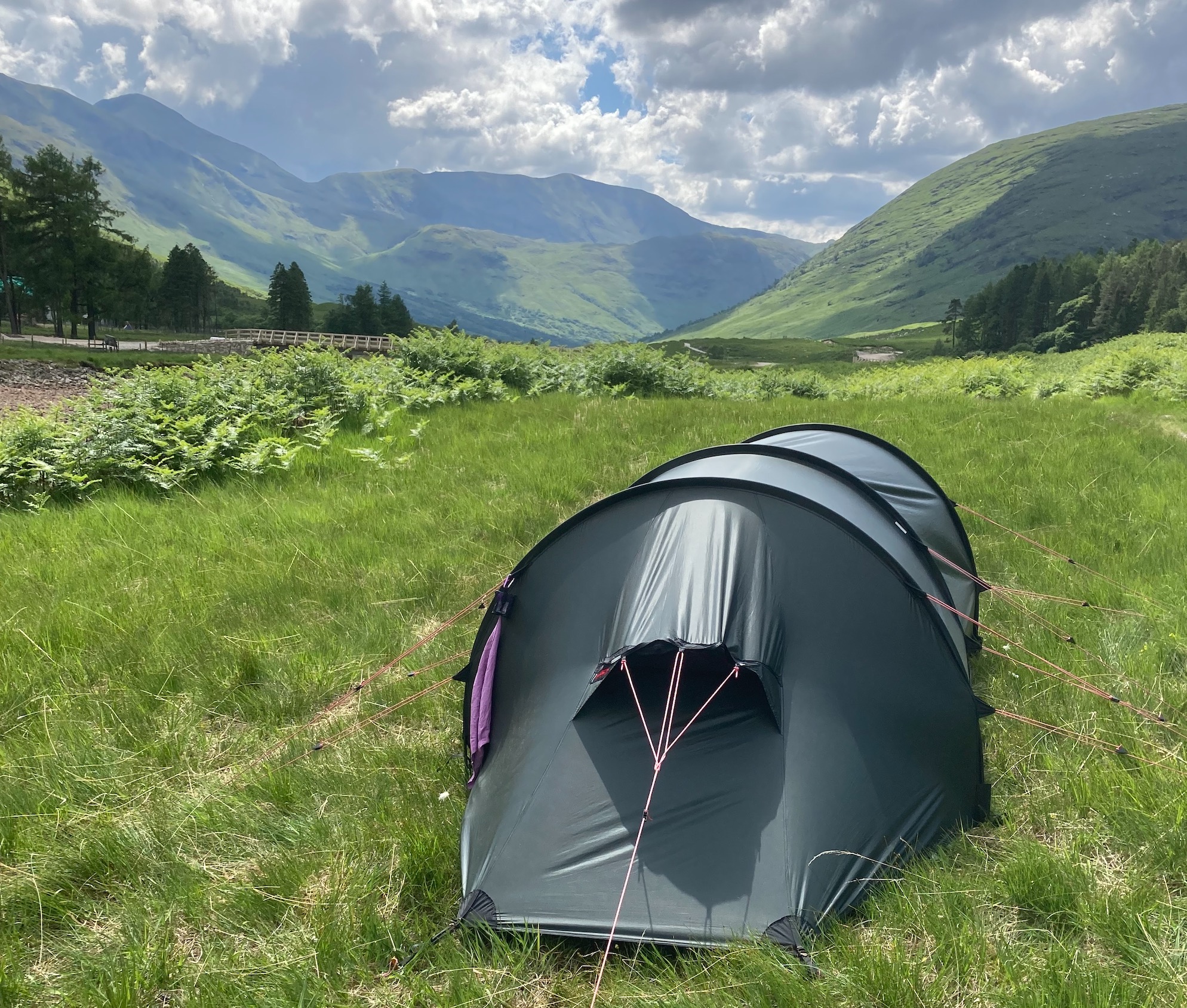
Glen Kinglass: room with a view! © Salyen Latter
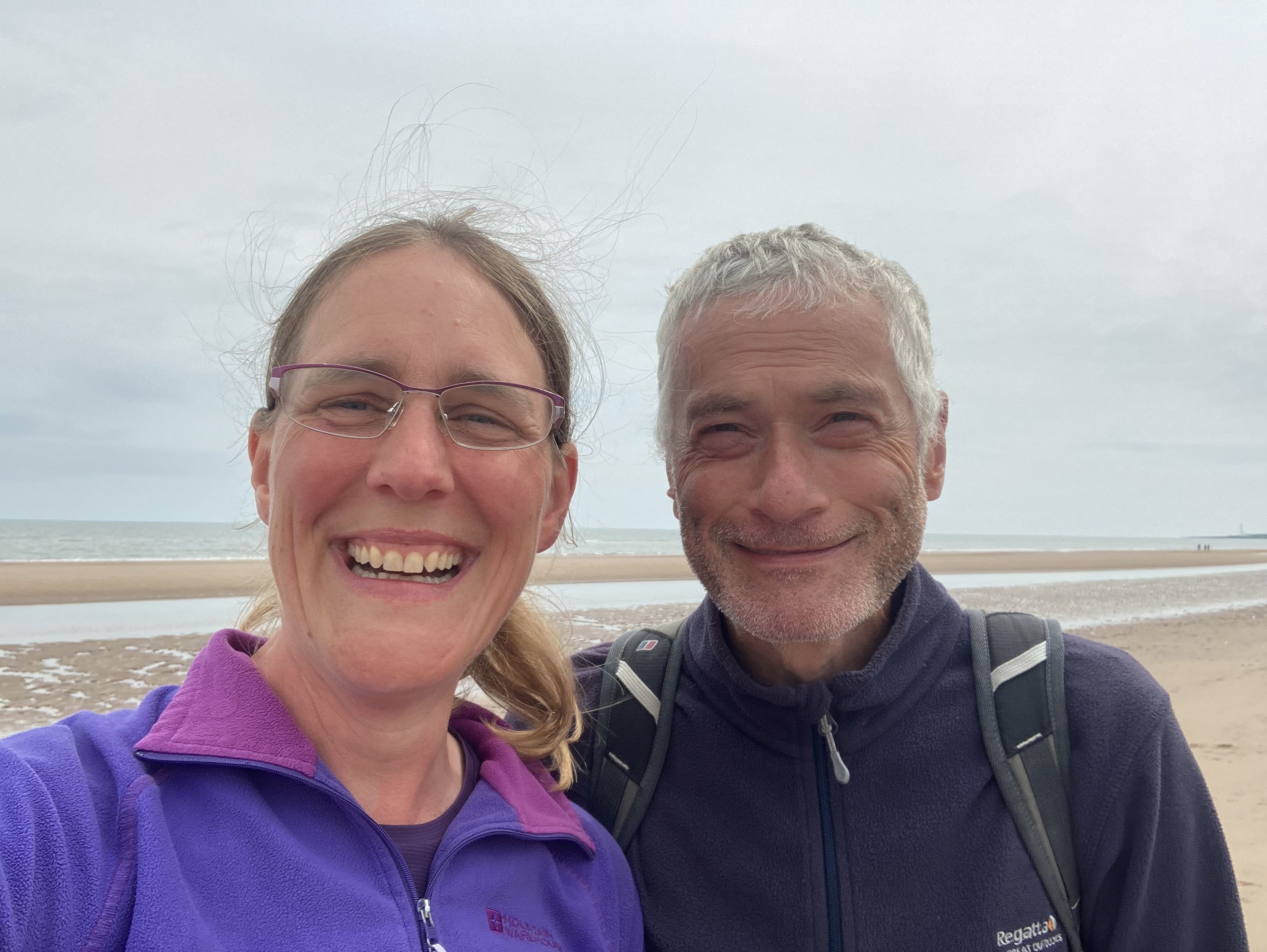
Salyen and Ian at the finish line © Salyen Latter

Loch Lyon sunset © Salyen Latter
This was our first TGO Challenge. Why did we want to do it? Many reasons: the challenge of plotting a route, the challenge of completion, the opportunity to walk through parts of Scotland we’d never been through before.
We set off, fresh-faced and ready from Oban. The day dawned bright and clear; how unusual in Scotland! Would it last for two whole weeks? Highly unlikely! But, hey, this is what it’s all about. The journey, the adventure, the challenge.
The first few days took us through Taynuilt, along the shores of Loch Etive, through Glen Kinglass and to Bridge of Orchy. Stunning views, peace, tranquillity; exactly what we had hoped it would be. But come Blair Atholl, it was apparent that the continual toll of walking in this heat was having an effect. Our feet, in particular Ian’s, were suffering. We were going to have to adapt our route – shorten our days, and take our time.
We ended up being the penultimate finishers of the Challenge, only hours ahead of the last! Did that matter? Not in the slightest. Because we had finished. This is not called a challenge for nothing!
What did we gain from this experience? Connectivity. With each other. With nature. With ourselves. This was the turning point in our relationship. I know of others who have made friends for life on these types of adventures. Some have even gone on to get married. I had already met my best friend and soul mate. But going on this adventure? It’s brought us closer. Living with someone in these conditions, it soon helps you realise whether you’re compatible or not. I know of folk who’ve done these trips with others and it’s been a complete disaster! For us? The opposite. We are truly as one, as a couple, as a team.
For all the people we met on the way, I have to say a huge thank you. The camaraderie was amazing. The stories, the tips, the experiences, just brilliant. For the organisers, vetters, volunteers and helpers, another massive thank you! Without you we probably wouldn’t have managed it.
Will we come back? Yes. Without a doubt. The thinking and planning has already begun…
This was Salyen and Ian’s first TGO Challenge.
A moment from the walk: Mount Battock summit day
Sandy Millar’s mind wanders to polar metaphors near Mount Battock
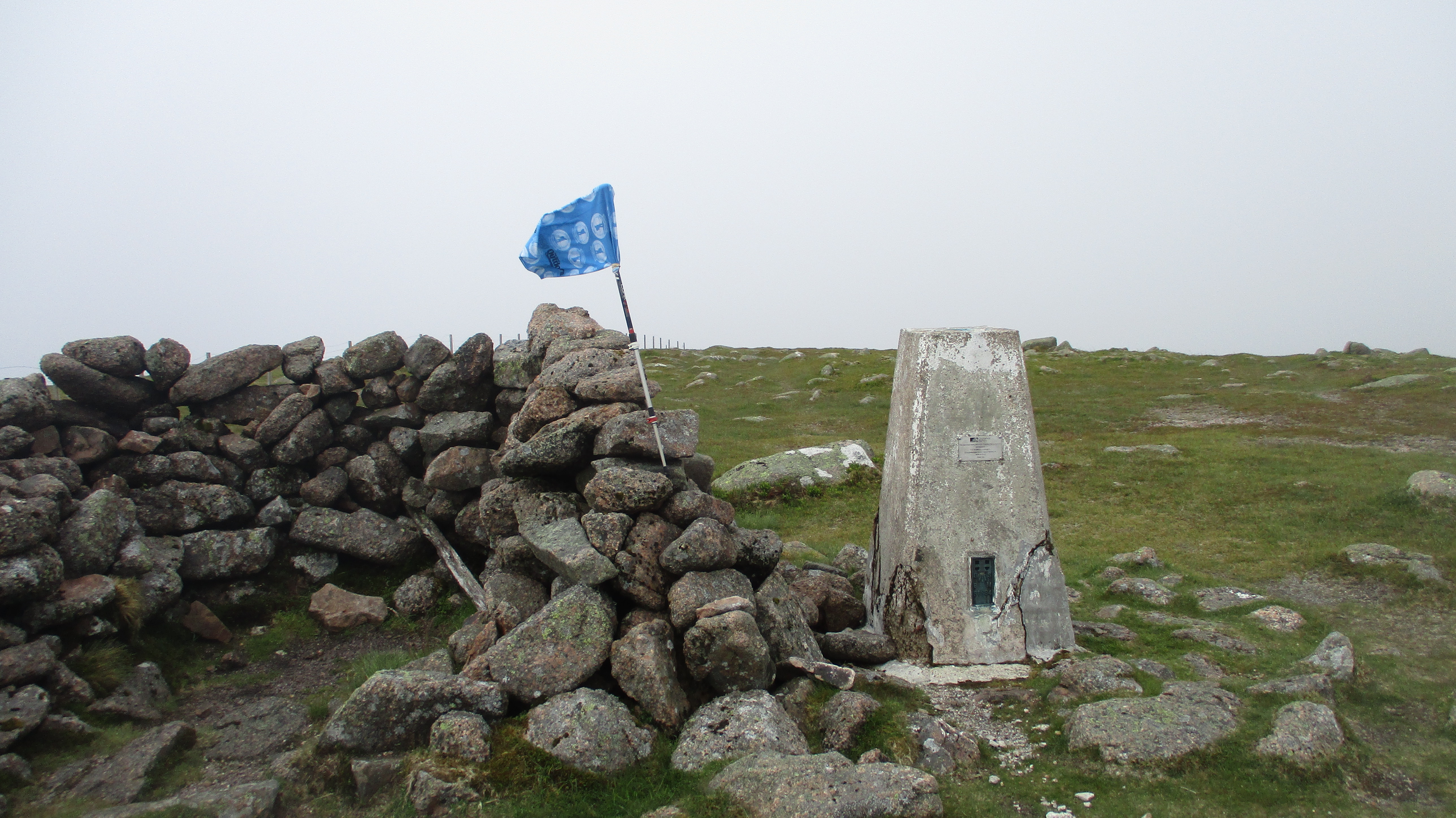
Mount Battock © Sandy Millar
Looking out of the tent I was met with dense cloud down to ground level. Long trousers and waterproof jacket on, I set off through the burnt heather up to the track. As I gained height the cloud started to lift, helped by the cold north wind. I thought that I would be alone and first to the summit, but no.
Ahead of me I could see a figure in the distance. At least, I consoled myself, Dr Fuchs, who came second when he went to the South Pole, was still a household name. No such luck; I spied yet another figure ahead. No one can name the nonentity that came after Dr Fuchs. That would have been me, if my destination were a bit more southerly. Funny how your mind wanders when it has time on its hands.
Over Mudlee Bracks, Hill of Cammie and then on to the summit of Mount Battock. There was no one there. I was alone, alone on top of the roof of the world. I had made it.
Behind me lay nearly 200 miles of swamp, desert, fly-infested foothills, scary dogs, midgies, blood-sucking arthropods, helpful locals, and some downright strange ones.
Looking over into Badymicks land lay the coast still far to the east. I only had one meal left, was down to my last tea bag and remaining four jelly babies; would I make it? I did.
It’s an adventure. Well it’s a challenge, with lots of planning, where to start, how to get there, the logistics of food supplies, the selection of where to pitch the tent – nice flat soft grass is everyone’s ambition, rarely fulfilled. Then there’s the comradery, meeting old friends, creating new ones. The physical challenge: am I fit enough and able enough to do it? There’s only one way to find out. Will I do it again?
Who wouldn’t.
Next year’s TGO Challenge: what’s the plan?
After the travails of the pandemic, the TGO Challenge will still not quite be back to normal next year. TGO Challenge coordinators Ali Ogden and Sue Oxley give us the latest update.
What constantly impresses us about Challengers is their loyalty to and support for the event and us as coordinators. Many have waited patiently to walk routes designed for 2020, but we strongly feel that those who were able to support us by walking this year also shouldn’t be disadvantaged.
Most who did participate this year have indicated they also want to take part in 2022. That leaves us with a conundrum, as we already have more people than places for next year – even before we look at taking new entrants. We can’t increase numbers without some other measures as previous limitations are there for good reasons.
So, for 2022 only, the plans are:
- 450–500 places, with those who missed out in 2020/21 or walked in 2021 having priority.
- A staggered start from Tuesday 10 to Friday 13 May, with 15 days to get to the east coast and a maximum of 125 starting on any day. Participants can start later but get a shorter time to cross as the event will finish on Friday 27 May.
- Those with guaranteed places will be invited to enter via email from 20 September to 11 October.
- Any unclaimed places will be offered to new entrants from 12-29 October at tgochallenge.co.uk and a draw will take place, if needed, in early November.
We hope this arrangement will prevent any start points or Highland villages being overwhelmed, whilst still maintaining the sociable side of the event. Sadly, this means we will have limited places for new entrants, but we hope to be fully back to normal in 2023.
Header image: Charles Harmer and Brian Whiteman on Muckle Cairn, Angus. © Ian Sinclair

